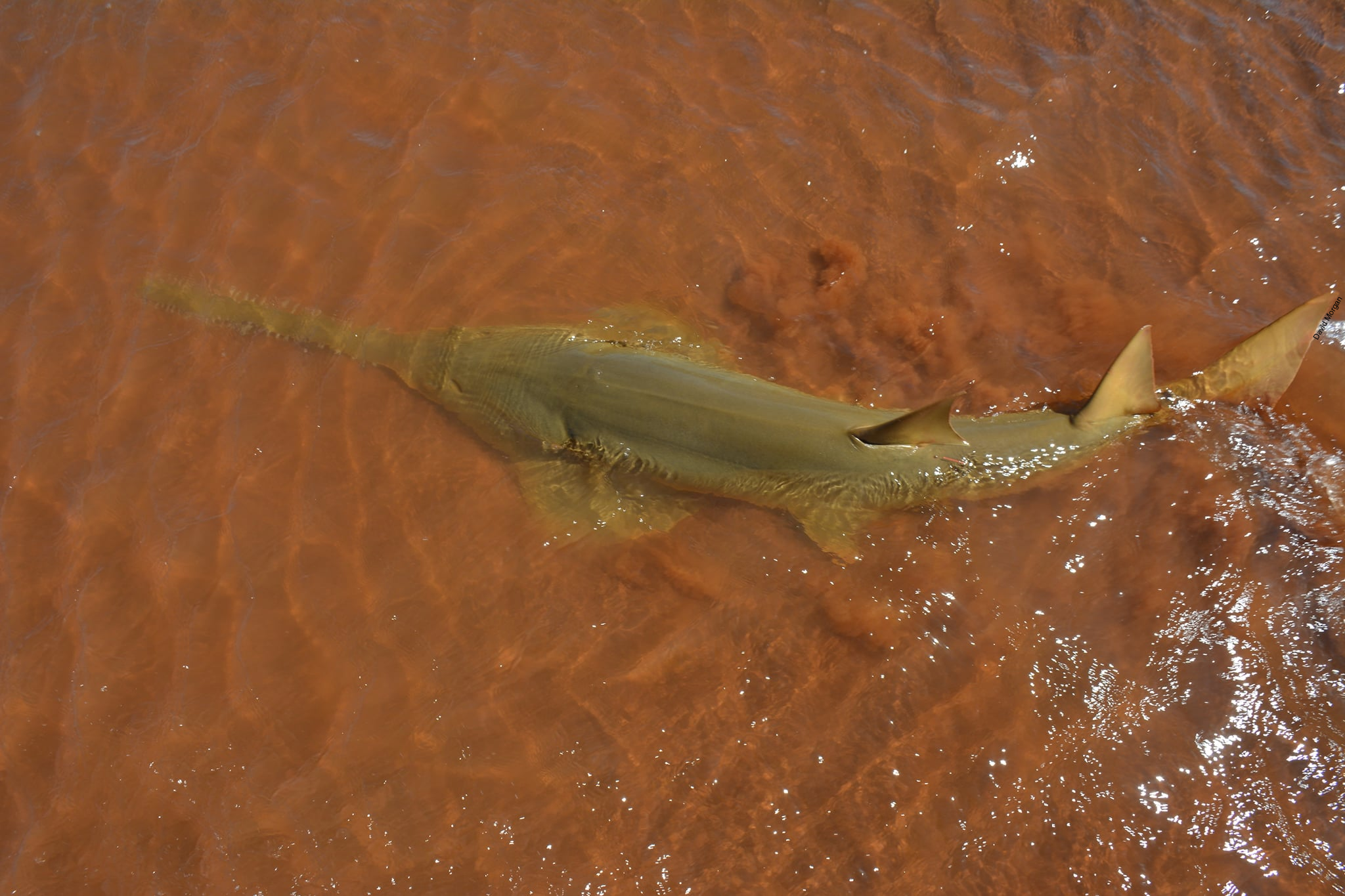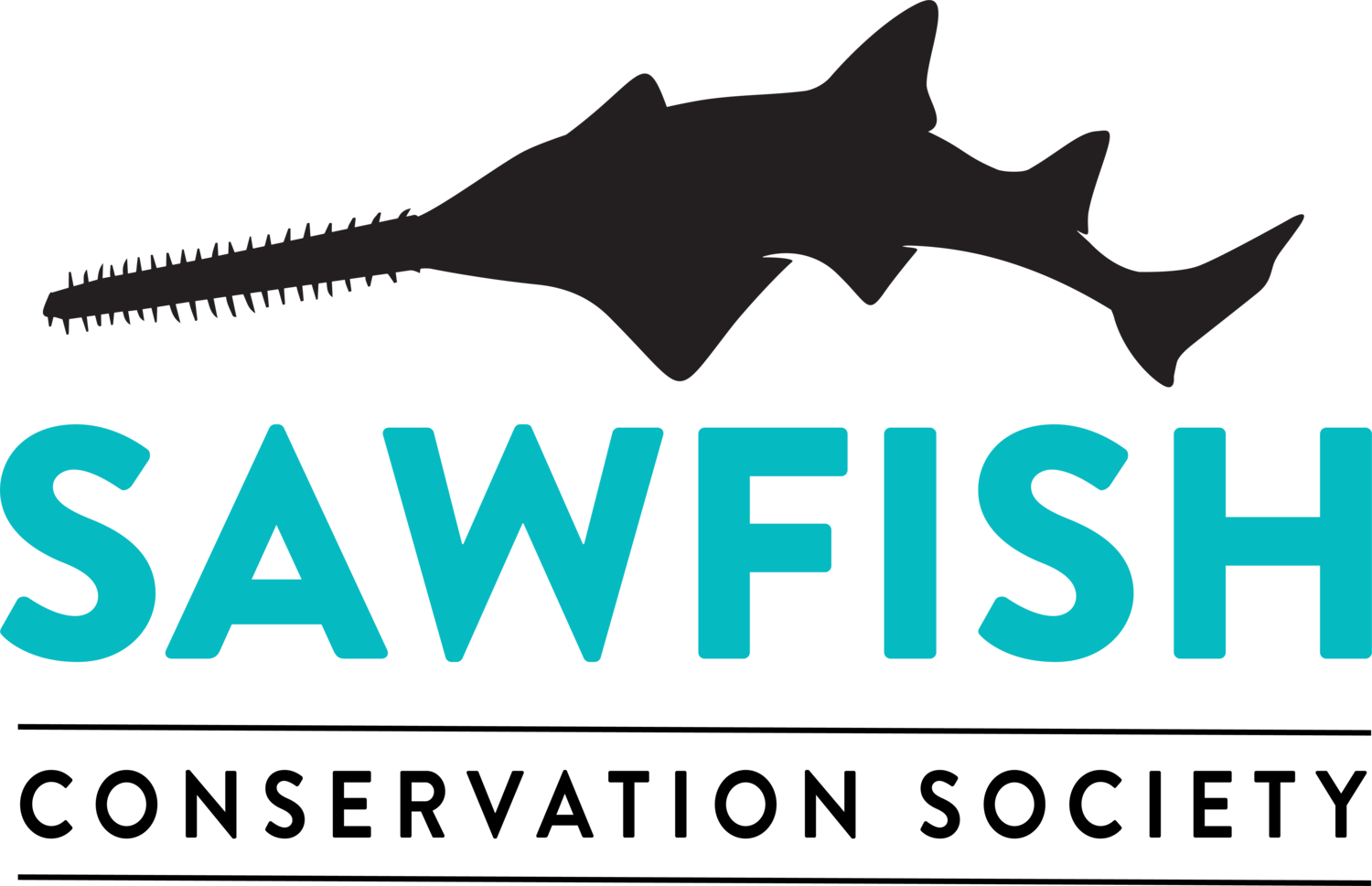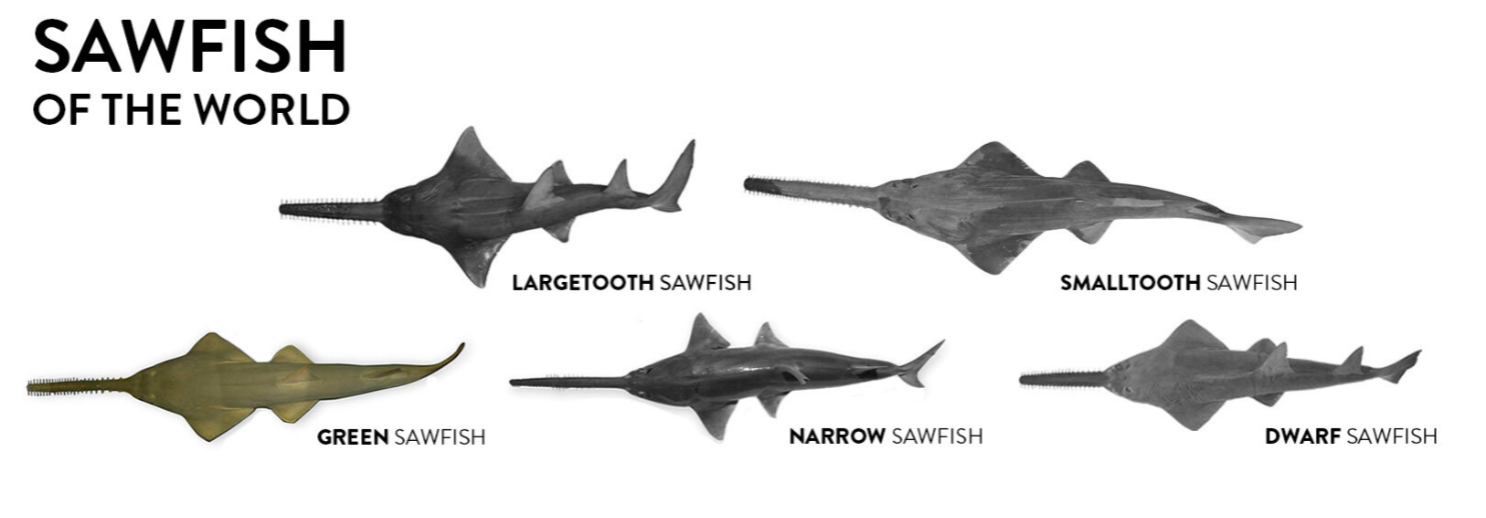
GREEN SAWFISH Pristis zijsron
IUCN status: CRITICALLY ENDANGERED
The green sawfish (Pristis zijsron) is a large sawfish that can grow over 600 cm (20 feet). This sawfish is found throughout the Indo-West Pacific in nearshore waters near sand and mud flats as well as deeper offshore waters. The green sawfish is best identified by it relatively long and narrow rostrum (i.e. saw), big change in rostral tooth gaps from the start to end of rostrum, and small to no lower caudal (tail) fin. Additionally, green sawfish typically have more rostral teeth (23-37) than other species within the Indo-West Pacific.
SIZE: 80 to 600+ cm (2.6 to 20+ feet) total length
DISTRIBUTION: Indo-West Pacific
IDENTIFICATION: Start of first dorsal (top) fin inline or just posterior to that of the pelvic (bottom rear) fin, lower lobe on caudal (tail) fin not present. Rostrum long and narrow with many rostral teeth that are farther apart near the base of the rostrum. Despite the name the green sawfish can be various shades of brown.
GREEN SAWFISH DESCRIPTION
Color: Green-brown dorsally and white ventrally.
Fin position/markings: No discernable markings on fins. Lower caudal fin lobe small to non-existant (Last and Stevens 2009). Origin of first dorsal fin inline or just posterior with that of the pelvic fin (Compagno and Last 1999). No anal fin.
Rostral meristics and morphology: Rostrum narrow, standard rostrum width (SRW) 9-17% of standard rotrum length (SRL) (Whitty et al. 2013). Width at tip 7 to 10 times wider than that at the base (Compagno and Last 1999). Standard rostrum length and total rostrum length (TRL) are 20-27% (SRL = 0.0733TL1.1683; Whitty et al. 2013) and 21-31% of TL in juveniles (TRL = 0.2825 TL – 3.7389; Faria 2007) (Faria 2007, Whitty et al. 2013). 23-37 pairs of rostral teeth (Compagno and Last 1999, Last and Stevens 2009, Faria et al. 2012). No significant difference between left and right rostral tooth counts (Whitty et al. 2013); bilateral asymetry of rostral tooth counts range between 0 and 3 (Whitty et al. 2013). Distal rostral tooth gap ranges between 10-50% that of the proximal tooth gap, increasing with size (Compagno and Last 1999, Whitty et al. 2013). Groove on posterior margin of tooth extending to base on anterior teeth in juveniles and the majority of teeth in adults (Compagno and Last 1999, Whitty et al. 2013).
Size: Pupped at 61 (Compagno and Last 1999) to ~80 cm TL and estimated to reach at least 540 cm TL (reported to reach 730 cm TL; Last and Stevens 2009).
Vertebral Count: Undocumented
GREEN SAWFISH HABITAT
Distribution: Recorded throughout Indo-West Pacific.
Habitat: Most captures of the species have been from nearshore, however interactions have been reported from commercial fisheries in 50-100 m depth.
GREEN SAWFISH LIFE HISTORY
Age and growth: Using a von Bertalanffy growth curve with P. zijsron aged between one and 18 years (482 cm TL), Peverell (2008) produced a k-value of 0.12 (Linfin = 540 cm, t0 = -1.12). Growth within the first year is 52 cm, but slows to 33 cm within the second year (Peverell 2008). Maximum age was estimated to be 53 years (540 cm TL), reaching asymptotic growth by 24 years (513 cm TL) (Peverell 2008). Pristis zijsron of 83-102 cm (n = 8), 128 cm (n = 1), 157-166 cm (n = 2), 220 cm (n = 1), 254-257 cm (n = 2), 380 cm (n = 1), 438 cm (n = 1), 449 cm (n = 1), and 482 cm (n = 1) TL were reported to be 0+, 1+, 2+, 3+, 5+, 8+, 10+, 16+ and 18+ years of age, respectively (Peverell 2008).
Reproduction: Aplacental viviparity (lecithotropic nutrition) (Stevens et al. 2005, Last and Stevens 2009). Litter sizes of approximately 12 pups (Last and Stevens 2009). Observed to pup in the wet season (Peverell 2005). Generation length is estimated to be 16 years (Stevens et al. 2005).
Maturity: Both sexes mature around 300 cm TL at ~ 9 years of age (Last and Stevens 2009). A pregnant females of 458 cm TL female was observed by Compagno and Last (1999) and a mature female of 380 cm TL was observed in Queensland by Peverell (2005).
DIETQueensland captured P. zijsron were found to have consumed Eleutheronema tetradactylum (Blue Salmon),Ambassidae (Asiatic Glassfish), Nibea aquamosa (Scale Croaker) and Pomadasys kaakan (JavelinGrunter; Peverell 2008) as well as Penaeus merguiensis (Banana Prawn) and Leiognathus bindus(Orangefin Ponyfish) (Stevens et al. 2005).
GREEN SAWFISH GENETICS
Signficant differences between haplotypes of Australian populations on the west coast and Gulf of Carpentaria as well as the on the east coast were documented through the use of a 352 bp portion of the mitochondrial control region, which is maternally inherited (Phillips et al. 2009b, 2011). Haplotype diversity of P. zijsron in Australia was observed to be moderate (Phillips et al. 2009b, 2011). The population(s) of P. clavata in the Gulf of Carpentaria appeared to have reduced levels of genetic diversity. This may suggest that the abundance in this region has been substantially reduced compared to the other sampled regions (i.e. east and west coast) within Australia (Phillips et al. 2009, 2011). Faria et al. (2012) found a single individual to share the same haplotype as those sampled in Australia.
GREEN SAWFISH CONSERVATION
Status of populations are unknown, but collected evidence demonstrates a large decline in Pristis spp. in Australian waters within the last 15-20 years (Stevens et al. 2005).
Pristis zijsron is listed as Critically Endangered on the IUCN red list. Listed as Vulnerable in Australia's EPBC Act, and is protected in state waters in Western Australia, Queensland and in the Northern Territory. Protection also provided in India. Pristis zijsron is on Appendix I of CITES, preventing international trade.

